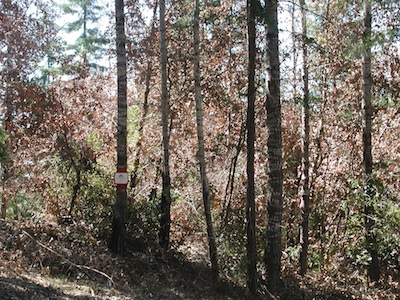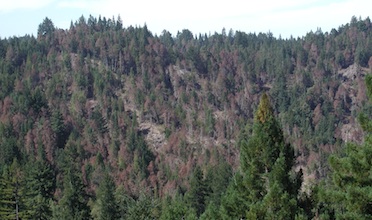Turtle Creek vs MRC
Thursday, January 24th, 2013by Annie Esposito
[courtesy of The Mendocino Country Independent]
14 June 2011
Neighbors of the Mendocino Redwood Company (MRC) are taking the company to task for the use of herbicides in their watershed.
Thirty of the fifty or so people who live in the Turtle Creek community, near Comptche, held a meeting with MRC last month. All of the neighbors who attended vehemently opposed MRC’s use of imazapyr to kill tanoaks.
Botanist Els Cooperrider told representatives from MRC, “Good Neighbors don’t poison the environment.” She said that imazapyr is worse than Garlon (triclopyr) and can persist for a year or 17 months. (The Environmental Protection Agency gives it a half-life of 17 months.)
MRC President Jim Holmes disagreed with that assessment of the herbicide, but it was clear that the neighbors didn’t want ANY poisons – period.
Imazapyr is the active ingredient in several broad-spectrum herbicides (Habitat, Chopper, Arsenal, and Assault). It’s banned in the European Union. Allen Cooperrider questioned how MRC could get its sustainable practices certification while using the herbicide. The Forest Stewardship Council (FSC) prohibits use of “hazardous chemicals.” But MRC holds a valid certification from FSC, good through November 2015.
Holmes told the group, “MRC is committed to sustainable forestry and restoration of the forest.” The logic is that the tanoak problem is a result of poor management, and getting rid of the tanoaks is a step in the direction of a healthy forest.
Aptly named MRC forester, Colby Forrester, gave a paper version of a powerpoint presentation, showing that every attempt to use alternatives has failed to take care of the tanoak problem. MRC uses “hack and squirt” to kill the tanoaks – hacking away a section of bark, then injecting the tree using a horse syringe. The systemic poison then kills the whole tree.
Forrester said that just cutting the trees didn’t work; because two years later there were multiple shoots. He produced photos of land where non toxic alternatives such as vinegar were used. Again, there was more growth after two years. But with imazapyr, there is no replacement growth at all. In fact, the photo proof that Forrester produced showed no growth of any kind where the herbicide was applied.
One of the neighbors produced his own photos – pictures of potential fuel loads of debris and dead tanoaks left behind after herbicide treatments. Neighbors argued that the use of poison was creating a fire hazard – even describing a whole ridge of dead tanoaks.
Several of the neighbors said that conifers eventually out-strip the tanoaks, and the tanoaks die off. The argument was that the only reason to poison them is to speed up the process for profit’s sake. There was agreement among the neighbors that if the company is in such a hurry, they should hire workers to remove the trees or let people come in and cut them for firewood.
Holmes said that liability would be a problem. He added that if the group wanted to take out insurance, they would talk about it. The neighbors, however, pointed out that the MRC, which is owned by the Fisher family of The Gap fortune, has more resources and MRC should take out the insurance. Neighbor Terri McCartney told MRC that the fire hazard from dead wood is a higher liability for the company than just letting people cut the wood.
Fifth District Supervisor Dan Hamburg asked if MRC’s use of herbicide really represented a change from the destructive practices of previous owner Louisiana Pacific. In a side note, he questioned MRC’s opposition to a conservation easement for Usal Forest. Holmes said that his company was concerned about the almost $20 million cost to taxpayers for the easement. (If approved by the Wildlife Conservation Board, the 50,635 acre Usal Redwood Forest Conservation Easement would be the largest contiguous area of protected coastal redwoods in the County.)
For the Turtle Creek neighbors, the THP in question is Dark Gulch Timber Harvest Plan. It has been approved; but no work will be done on it this year. This gives the two sides some time to negotiate. Attorney Barry Vogel tried to pin MRC President Holmes down on the company’s intention to use Imazapyr next year. Holmes said that the concerns of the group would be “taken under advisement.”
The meeting echos another community meeting with MRC in Westport in April. Neighbors there have organized a committee to work with MRC on the issue of herbicide use in the forest.
 His careful subject avoidance reminded me of the tobacco industry, who for decades after everyone else had figured it out, kept pretending that there was no connection between smoking and cancer. A big difference in these two situations is that one could choose not to be a smoker; whereas, here, we are unwilling participants in MRC’s poisoning of the environment.
His careful subject avoidance reminded me of the tobacco industry, who for decades after everyone else had figured it out, kept pretending that there was no connection between smoking and cancer. A big difference in these two situations is that one could choose not to be a smoker; whereas, here, we are unwilling participants in MRC’s poisoning of the environment. I mourn for all of us in western Mendocino County. What you can see along the Comptche Ukiah Road this year, MRC has been doing in more hidden locations all along. From our property, we see large fields of MRC Brown along tributaries of the Navarro River. MRC averages two tons of imazapyr on over five thousand acres every year. That’s a huge toxic load on us all. Doesn’t it seem like too many people are getting cancer these days? MRC is helping make that happen.
I mourn for all of us in western Mendocino County. What you can see along the Comptche Ukiah Road this year, MRC has been doing in more hidden locations all along. From our property, we see large fields of MRC Brown along tributaries of the Navarro River. MRC averages two tons of imazapyr on over five thousand acres every year. That’s a huge toxic load on us all. Doesn’t it seem like too many people are getting cancer these days? MRC is helping make that happen.